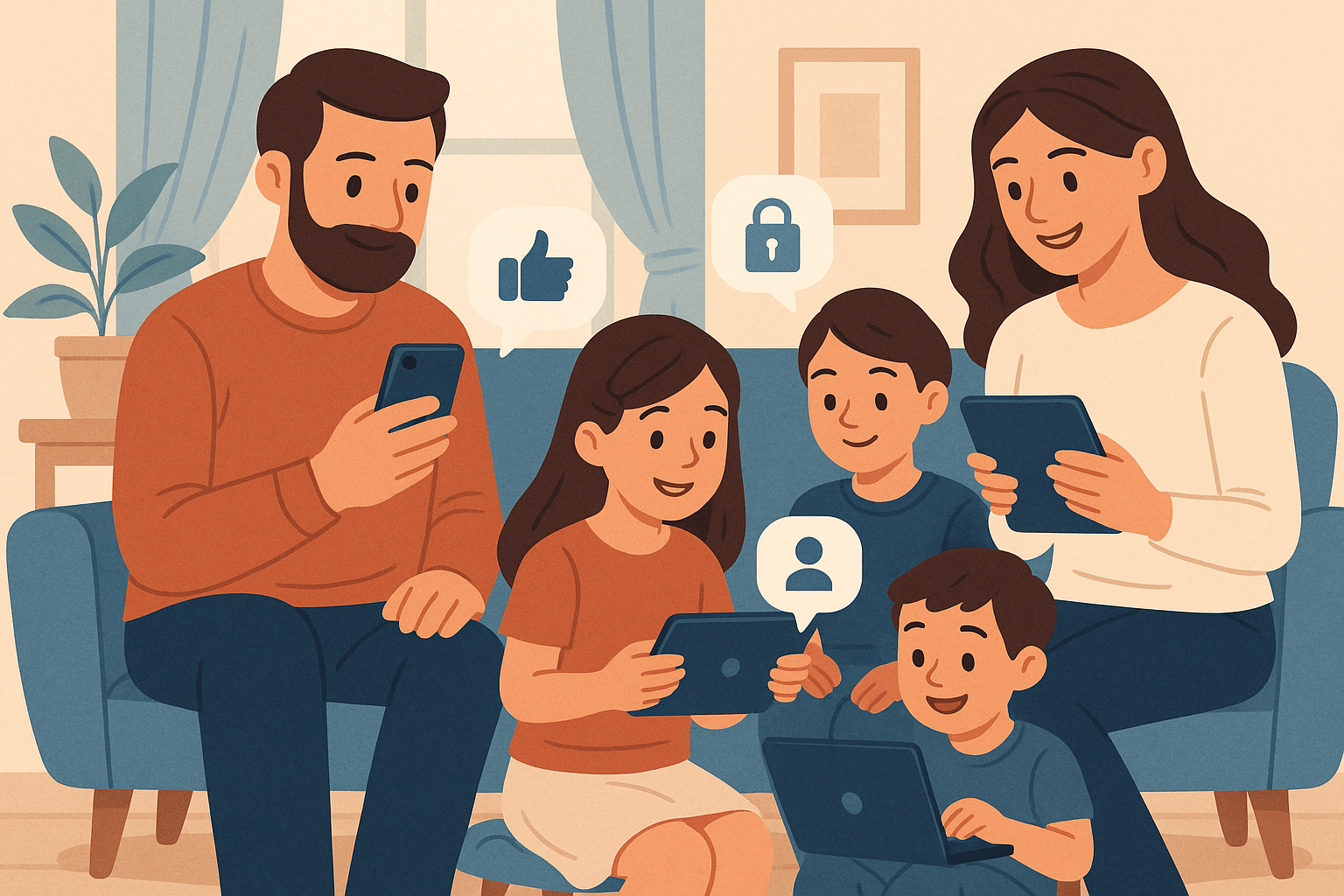Introduction to Sharenting
Before their second birthday, 40% of children already have a digital footprint created by their parents, but what happens when these children grow up and discover their entire childhood documented online? In an era where social media dominates our lives, parents face unique challenges and decisions regarding their children’s presence online. ‘Sharenting,’ the act of sharing content about one’s children on social media, requires a delicate balance of pride and privacy. This comprehensive guide explores the essential dos and don’ts for parents navigating this digital landscape.
Understanding the Sharenting Phenomenon
Understanding sharenting involves delving into the fusion of parenthood and the digital age, characterised by the inclination of parents to share their children’s lives on social media. The term itself, a portmanteau of “sharing” and “parenting,” first emerged around 2013, stemming from the broader phenomenon of social media’s evolving role in personal and family life.
As platforms like Facebook, Instagram, and Snapchat gained traction, parents began to curate online representations of their families, often sharing experiences, milestones, and daily activities pertaining to their children. What may have started as a benign practice of keeping family and friends updated has transformed into a widespread cultural trend that presents both benefits and challenges.
The Numbers Behind Sharenting
Recent statistics showcase the prevalence of sharenting globally. According to research conducted in 2020, approximately 70% of parents admitted to sharing images or stories about their children online. This trend is particularly noticeable among Millennial and Gen Z parents, who were raised during the rise of social media.
The statistics are staggering:
- 40% of children, particularly in the U.S. and the U.K., have an online presence created by their parents before reaching age two
- The average child has around 1,500 images posted by their parents by age five
- 70% of hiring managers check a candidate’s online presence during recruitment
Such figures reveal the sheer extent to which sharenting has integrated into familial dynamics and societal norms.
The Double-Edged Nature of Digital Sharing
While sharenting may appear innocuous and even beneficial in fostering connections, it raises significant concerns regarding children’s privacy. As parents share stories and images of their children, they inadvertently expose them to a realm where such content can be misused or misinterpreted.
There have been instances of personal images finding their way into inappropriate contexts, amplifying the risks associated with oversharing. The children who are the subjects of these posts may later face challenges regarding their digital identity and personal autonomy, potentially leading to conflicts over what was shared without their consent.
From a positive perspective, sharenting can offer support and validation, building a sense of community among parents navigating the trials and triumphs of child-rearing. Many parents find camaraderie in sharing similar experiences, which can foster discussions about parenting techniques, educational resources, and emotional support.
The Essential Dos of Responsible Sharenting
Implement Age-Appropriate Consent Protocols
As your children mature, it becomes essential to include them in the decision-making process regarding what aspects of their lives you choose to share online. Consent should not be a vague concept reserved for the legal world; instead, it should be a standard part of your family’s online habits.
Children begin to develop a sense of self and privacy at an early age, and by inviting them to discuss what they are comfortable sharing, you cultivate their autonomy and respect their boundaries.
Age-Specific Consent Guidelines:
- Ages 3-6: Use simple language like “Should we show Grandma this picture?”
- Ages 7-11: Ask direct questions: “How do you feel about me posting your pictures?”
- Ages 12+: Give them veto power and collaborative decision-making authority
Consider having regular conversations about privacy, the digital footprint, and the implications of being online. Respecting their input helps children feel valued and understood, reinforcing trust and open communication within the family.
Prioritise Comprehensive Privacy Protection
One of the cornerstones of responsible sharenting is respecting your child’s privacy. This not only strengthens your relationship with your child but also teaches them the importance of managing their own privacy as they grow older.
Privacy Protection Checklist:
- Avoid sharing full names, school details, or location information
- Remove metadata from photos before posting
- Use platform-specific privacy features (Instagram Close Friends, Facebook custom lists)
- Regularly audit and update privacy settings
- Consider using privacy-focused family sharing apps
Be mindful of the medium you choose for sharing. Some platforms are inherently less secure than others, and your child’s image could be exposed to a broad audience far beyond your family and friends. Assess the privacy settings on your social media accounts regularly, as these frequently change.

Transform Moments into Empowering Narratives
When engaging in sharenting, strive to focus on positive storytelling rather than sharing embarrassingly candid moments. Although funny stories can feel like harmless sharing in the moment, they can lead to long-term ramifications for your child as they grow older.
Before Posting, Ask Yourself:
- Would I be comfortable with this content in a job interview setting?
- Does this respect my child’s dignity and future autonomy?
- Am I sharing this for community value or personal validation?
- How might my child feel about this post at age 16?
Instead of focusing on mishaps or challenges, highlight achievements, memorable experiences, or obstacles your child has overcome. By framing your posts in a positive light, you build a more supportive online environment while inspiring others facing similar challenges.
Establish Clear Boundaries Around Sensitive Content
While it’s natural to seek support through social media, it is essential to tread carefully when discussing personal or sensitive issues. Topics such as mental health struggles, learning disabilities, or behavioural challenges should be approached with extreme caution.
Content That Should Never Be Shared:
- Health information or medical conditions
- Disciplinary actions or behavioural challenges
- Bathroom-related content or states of undress
- Emotional breakdowns or vulnerable moments
- School performance details or learning difficulties
Instead of posting about difficult situations publicly, consider utilising private conversations or support groups to seek advice. Not everything needs to be broadcast online, and sometimes a more personal connection can offer the support you need without compromising your child’s dignity.
Foster Authentic Community Connections
Sharenting done thoughtfully can foster a sense of community among parents. The digital age allows for connections that span across geographic barriers, opening channels for sharing experiences, tips, and support.
Building Positive Communities:
- Participate in evidence-based parenting forums
- Join local parent groups with strong community guidelines
- Share helpful resources without identifying personal details
- Focus on mutual support rather than social validation
- Engage with content that promotes respectful dialogue
Engagement in positive sharenting practices within these groups can support new parents while reinforcing responsible boundaries.
Critical Don’ts: Protecting Your Child’s Digital Future
Avoid Sharing Sensitive Personal Content
One of the most significant dangers associated with sharenting is the sharing of sensitive content about children. Personal anecdotes, such as detailing a child’s struggles with developmental milestones or sharing their emotional responses to various situations, can inadvertently expose private experiences.
It’s crucial to remember that what might seem humorous or endearing to a parent could be humiliating to a child as they grow. Children are often unaware that these posts can impact their self-image in the long term, and what feels innocent to an adult can feel like an invasion of privacy to a child, especially as they become more socialised.
Recognise the Permanent Consequences of Oversharing
Oversharing not only affects a child’s feelings of privacy but also contributes to an expansive digital footprint that they may not be prepared to manage later in life. With the permanence of the internet, every image or story shared can follow a child into adulthood.
Long-term Impact Considerations:
- College admissions officers increasingly review applicants’ digital presence
- Future employers routinely check candidates’ online footprints
- Peer relationships can be affected by embarrassing childhood content
- Mental health impacts from knowing their lives are permanently documented
Research has shown that a child’s digital footprint can influence future opportunities, from college admissions to job prospects, with nearly 70% of hiring managers checking candidates’ online presence during recruitment.
Protect Against Digital Exploitation and Misuse
The potential for exploitation is alarmingly high in today’s digital age. When parents upload images of their children, particularly if they are shared publicly, this makes them susceptible to a vast audience, some of whom might have harmful intentions.
A simple photo of a child at a birthday party can potentially be misused if it falls into the wrong hands. The reality is that without strict privacy settings, images intended for close family and friends can be shared, reshared, and manipulated by individuals with ill intentions.
Security Considerations:
- Even with privacy settings, content can be screenshotted and redistributed
- Facial recognition technology can be used to track children across platforms
- Images can be taken out of context and used inappropriately
- Location data embedded in photos can reveal personal information
Understand Legal and Ethical Implications
Laws related to children’s privacy vary from jurisdiction to jurisdiction, and parents may unknowingly violate these regulations when sharing their child’s likeness. In some places, there are stringent laws about using images of minors, even in family contexts.
Legal Considerations by Region:
- European Union: GDPR provides strong privacy protections for minors
- France: Children have legal rights to request the removal of parent-shared content
- United States: State laws vary significantly regarding children’s digital rights
- United Kingdom: Increasing focus on children’s digital privacy rights
Before sharing content, consider whether your posts align with local regulations regarding privacy and consent, as legal frameworks continue to evolve rapidly.
Creating a Sustainable Digital Balance
Develop Comprehensive Family Digital Policies
Finding a balance between sharing moments from family life and respecting children’s privacy requires intentional planning. Successful families often develop written policies that outline acceptable sharing practices.
Essential Policy Elements:
- Clear definitions of shareable versus private content
- Age-appropriate consent procedures
- Platform-specific guidelines and restrictions
- Regular review and update schedules
- Consequences for policy violations
- Emergency procedures for unwanted content exposure
Parents can develop a family social media policy that outlines the types of content that can be shared, who can see it, and the frequency of posts. This collaborative framework teaches children responsible digital citizenship and the importance of respecting others’ privacy.
Explore Privacy-Focused Alternatives
Consider alternatives to public sharing by utilising private groups and messaging apps, where you can share memories exclusively with family and close friends.
Alternative Documentation Methods:
- Private family apps: Use platforms like FamilyAlbum or 23snaps with enhanced privacy controls
- Password-protected family websites: Create restricted-access sites for extended family
- Physical keepsakes: Develop photo books, scrapbooks, or journals
- Private cloud sharing: Use secure platforms for family-only content
Creating physical or digital keepsakes can serve as beautiful alternatives to oversharing while maintaining family connections without public exposure.
Model Responsible Digital Behaviour
Children are observant and often mirror their parents’ behaviours. Therefore, it’s important for parents to model responsible social media practices themselves. By openly discussing their own social media experiences, including the decisions they make about what to share and what to keep private, parents can instil in children the importance of mindfulness and discretion.
Modelling Strategies:
- Discuss your own social media decision-making process
- Explain why you chose not to share certain content
- Demonstrate privacy setting management
- Show how to handle negative online interactions
- Discuss the difference between online personas and real life
Advanced Considerations for Modern Families
Platform-Specific Risk Assessment
Different social media platforms present unique risks and benefits that parents must understand before sharing content about their children.
| Platform | Primary Risks | Recommended Approach |
|---|---|---|
| Visual oversharing, public discovery | Use Close Friends, avoid hashtags | |
| Data collection, broad reach | Custom friend lists, restricted sharing | |
| TikTok | Algorithm exposure, young audience | Avoid entirely for child content |
| Screenshot sharing | Preferred for private family sharing | |
| Snapchat | False sense of privacy | Use with extreme caution |
Preparing Children for Digital Independence
As children approach adolescence, begin preparing them to eventually manage their own digital presence. This includes teaching them about digital footprints, online reputation management, and the long-term consequences of digital choices.
Digital Literacy Education Timeline:
- Ages 8-10: Introduce basic privacy concepts and digital permanence
- Ages 11-13: Teach platform-specific privacy settings and security measures
- Ages 14-16: Discuss reputation management and professional online presence
- Ages 17+: Transition to collaborative oversight and independent management
Staying Current with Evolving Technology
The digital landscape evolves rapidly, with new platforms, features, and risks emerging regularly. Parents must commit to ongoing education about digital trends and their implications for family privacy and safety.
Staying Informed:
- Follow reputable digital parenting resources and experts
- Attend workshops on family digital safety
- Join parent communities focused on responsible technology use
- Regularly review and update family digital policies
- Stay informed about changing privacy laws and platform policies
Conclusion
Navigating the world of social media as a parent requires thoughtful consideration, ongoing dialogue, and a commitment to prioritising children’s well-being over social validation. By understanding the implications of sharenting and adhering to evidence-based best practices, parents can foster a safe and respectful online environment for their children.
The goal is not to eliminate sharing entirely but to approach it with intentionality, respect, and awareness of long-term consequences. Striking the right balance can enhance family connections and community support while protecting children’s privacy, autonomy, and future opportunities.
As technology continues to evolve, so too must our approaches to responsible digital parenting, always keeping our children’s best interests at the forefront of our online interactions. Remember that responsible sharenting is an ongoing journey that requires regular evaluation, open communication, and a willingness to adapt as both technology and children evolve.
By implementing these comprehensive strategies, families can enjoy the benefits of digital connection while safeguarding what matters most: their children’s privacy, dignity, and future autonomy in an increasingly connected world.
Frequently Asked Questions About Sharenting
What exactly is sharenting and when did it start?
Sharenting is a combination of “sharing” and “parenting” that refers to the practice of parents posting content about their children on social media platforms. The term first emerged around 2013 as social media became integral to family life. What began as innocent updates for distant family members has evolved into a widespread cultural phenomenon where parents document and share their children’s milestones, daily activities, and experiences online.
How common is sharenting among modern parents?
Sharenting is extremely prevalent in today’s digital parenting landscape. According to recent research, approximately 70% of parents admit to sharing images or stories about their children online. The statistics are particularly striking for young children: 40% of children have an online presence created by their parents before their second birthday, and the average child accumulates around 1,500 images posted by their parents by age five.
At what age should I start asking my child’s permission before posting about them?
You should begin age-appropriate consent conversations as early as possible, adapting your approach as your child develops:
Ages 3-6: Use simple questions like “Should we show Grandma this picture?”
Ages 7-11: Ask directly, “How do you feel about me posting your pictures?” and explain digital permanence
Ages 12+: Give them veto power over content featuring them and involve them in privacy decisions
The key is starting these conversations early and respecting their responses, even when they seem unreasonable.
What type of content should I never share about my child?
Certain content should remain completely private to protect your child’s dignity and future opportunities:
Health information, medical conditions, or therapy details
Disciplinary actions or behavioural challenges
Bathroom-related content or images of undress
Emotional breakdowns or vulnerable moments
School performance details or learning difficulties
Any content that could be embarrassing as they grow older
Remember: what seems cute at age 3 may cause significant embarrassment at age 13.
Can sharenting affect my child’s future job prospects?
Yes, sharenting can have long-term consequences for your child’s future opportunities. Research shows that nearly 70% of hiring managers check candidates’ online presence during recruitment. College admissions officers also increasingly review applicants’ digital histories. Content shared during childhood can follow them into adulthood, potentially affecting peer relationships, educational opportunities, and career prospects. This is why it’s crucial to consider the “future job interview test” before posting.
How can I protect my child’s images from being misused online?
To protect your child from digital exploitation:
Use strict privacy settings and regularly audit them (platforms change policies frequently)
Remove metadata from photos before posting
Avoid sharing identifying information like full names, school details, or locations
Use platform-specific privacy features (Instagram Close Friends, Facebook custom lists)
Consider that even with privacy settings, content can be screenshotted and shared
Use private family-only apps or password-protected sharing when possible
Remember that facial recognition technology can track children across platforms
Are there legal issues I should be aware of when sharing content about my child?
Yes, legal considerations around sharenting are evolving rapidly and vary by jurisdiction:
European Union: GDPR provides strong privacy protections for minors
France: Children have legal rights to request the removal of parent-shared content
United States: State laws vary significantly regarding children’s digital rights
United Kingdom: Increasing focus on children’s digital privacy rights
Some jurisdictions have strict laws about using images of minors, even in family contexts. Before posting, consider whether your content aligns with local regulations regarding privacy and consent. It’s advisable to stay informed about changing legislation as children’s digital rights continue to evolve.
Perfect: Feeling Judged on Social Media

Disclosure: As an Amazon Associate, I earn from qualifying purchases. This means that if you click on a link and make a purchase, I may receive a small commission at no additional cost to you.
References and Sources
Academic Research Sources
Walrave, M., et al. (2023)
“Mindful sharenting: how millennial parents balance…” – PMC study examining parents’ motives for engaging in mindful sharenting and strategies they implement. Published in a peer-reviewed journal with 45 citations.
Steinberg, S. B. (2017)
“Sharenting: Children’s Privacy in the Age of Social Media” – Emory Law Journal, Vol. 66, Issue 4. First in-depth legal analysis of the conflict between parents’ right to share and children’s privacy interests.
Walrave, M., et al. (2022)
“The Limits of Sharenting: Exploring Parents’ and…” – Frontiers in Education study investigating adolescents’ attitudes toward sharenting and privacy management strategies. 43 citations.
Keskin, A. D., et al. (2023)
“Sharenting Syndrome: An Appropriate Use of Social Media?” – PMC study examining sharenting as a syndrome and developing measurement tools. 40 citations.
Statistical Sources
Security.org (2021)
“Parents’ Social Media Habits: 2021” – Survey of 1,000 parents and teens showing 77% of parents share content about their children online.
Nominet Research
Data showing average parent posts almost 1,500 photos of their child before their fifth birthday.
Legal and Regulatory Sources
UN Convention on the Rights of the Child
Referenced in Oxford Academic study examining regulatory frameworks around children’s privacy.
US Children’s Online Privacy Protection Act (COPPA)
Legal framework governing data collection from children online.
European General Data Protection Regulation (GDPR)
Privacy protections for minors in European Union.
Expert Commentary Sources
Bessant, C. (2025)
Northumbria University Associate Professor in Law – Expert commentary on sharenting implications published in The Conversation.
Cook, L. (2022)
West Virginia University social marketing and public policy researcher – Studies on sharenting risks published in The Journal of Consumer Affairs.
International Research
Reich, C. J. (2024)
Norwegian study analysing sharenting practices and parent-child tensions.
Sarkadi, et al. (2020)
Swedish study surveying children’s attitudes toward sharenting.
Disclaimer: This guide is for educational purposes only and does not constitute legal advice. Consult with qualified professionals for specific concerns about your family’s digital practices or legal obligations regarding children’s privacy rights.


